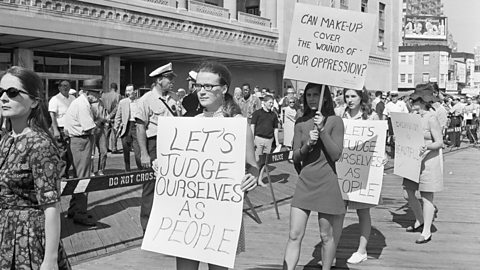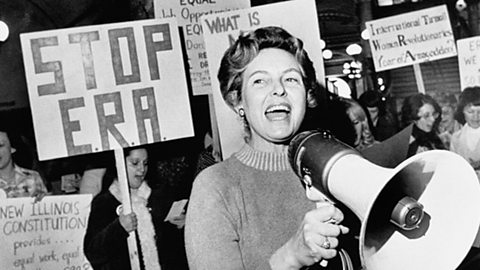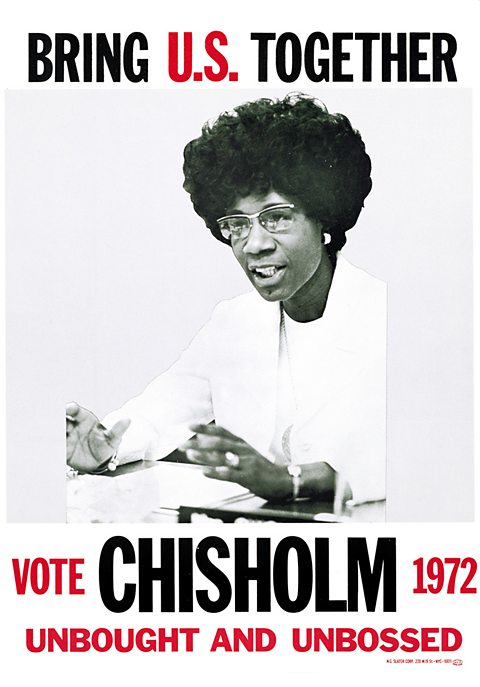The feminist movement
The changes in womenās working lives that had occurred during World War Two did not last into the post-war period. The ideal of the American dreamThe idea that everyone in the USA has the chance to be successful and happy if they work hard. consumer culture and the growth of suburbsThe outskirts of a town or city. areas all encouraged women to adopt what were seen at the time as 'traditional family roles'. However, by 1960 women made up around half of the workforce. For many women, earning their own income provided them with a new sense of independence.
In the 1960s and 1970s, the idea of a woman's role being limited to a housewife and mother was challenged by a strong feminist Someone who supports the belief that women should have the same rights and opportunities as men. movement. The movement advocated and campaigned for the rights and equality of women.
The 1963 Presidential Commission on the Status of Women
In 1961, President John F Kennedy set up the Presidential Commission on the Status of Women to report on women in the workplace. In 1963, it reported that:
- women earned around 60 per cent less than men for the same job
- around 95 per cent of managers were men - the majority of work for women was part time and with limited responsibility
- well-paid professional jobs, such as lawyers and doctors, were mostly done by men
The development of the feminist movement
Building on the success and methods of the civil rights movement, the feminist movement developed in the late 1960s. Activists organised using a range of methods to advocate for womenās rights.
The fight for equality
Betty Friedan became a key leader in the feminist movement. In 1963, her influential book The Feminine Mystique she expressed how unhappy many women felt with being housewives and mothers. She stated, at the time, her belief that some women were dangerously adjusted to oppressive lives as housewives and urged for progress in employment opportunities.
In 1966, Friedan and 48 other activists set up the National Organization for Women (NOW). One of their initial and continuing goals was to work towards ending discriminationTo treat someone differently or unfairly because they belong to a particular group. in employment - to achieve equality in wages between women and men working in the same roles. They mostly tried to get laws passed to ensure equality and used legal action in the courts to win discrimination cases.
NOW also advocated for child-care provision for working mothers, the right to paid maternity leave and legalised abortion.
The struggle for liberation
NOW was one of a number of branches within the feminist movement. The members of NOW were mainly middle-class and middle-aged women. Other activists focused on confronting patriarchal societyA society in which men hold the power and control. as the root of womenās inequality. They believed their role was to work together for freedom from men's control and oppression of women, rather than for just legal equality with them.
This group became known as the womenās liberation movement, or womenās lib. It especially appealed to younger women who often wanted to take direct action. For example:
- activists protested at the 1968 Miss America beauty pageant, arguing that events like this exploited and degraded women
- womenās liberationists held meetings to give women spaces to explore how and why they were exploited

The 1972 Equal Rights Amendment

CongressThe legislative body of the US government, made up of the Senate and the House of Representatives. passed the Equal Rights Amendment (ERA) in 1972. The ERA stated that equality "must not be denied on account of sex". The ERA needed to be ratifyAn agreement being officially agreed on by a country. by at least 38 states for it to become part of the US Constitution. However, it encountered strong opposition. The STOP ERA campaign was led by conservativePeople who prefer to keep to old ways and only reluctantly allow changes in traditional beliefs and practices. such as Phyllis Schlafly, who believed equality under the law would undermine traditional family life and require women to fight in the military on the same basis as men. The Equal Rights Amendment was defeated by its opponents, as it did not receive ratification from the required number of states.
Roe v Wade, 1973

Americans were deeply divided on the issue of abortion. Until 1973, each individual state could decide its own policy. In that year, after a court hearing involving a woman referred to as Jane Roe to protect her identity, theĀ United States Supreme CourtThe highest court in the USA. It has the power over all courts in the country.Ā ruled in theĀ Roe v WadeĀ judgement that all women had a constitutional right to get an abortion in early pregnancy.
In 2022, a Supreme Court ruling overturned Roe v Wade and individual states are now able to ban abortion if they wish.
The impact of the feminist movement
The feminist movement empowered many women and gave them a greater voice in society and politics. A generation of women became politicised and more women became notable figures in politics. For example, Shirley Chisholm became the first black woman member of Congress.
The movement also encountered setbacks. For example, in 1972 Congress passed a programme to make child-care facilities more widely available. However, President Richard Nixon deemed this a threat to traditional views of family life and vetoThe official power to stop new laws being passed or reject courses of action. it.